AI Email Personalization at Scale: Tools, Techniques, and Implementation Guide for B2B Teams
How to Use Leading LLMs to Deliver Tailored Email Outreach at Scale
Blogby JanAugust 10, 2025

The era of "Hi [First Name]" personalization is over. B2B teams using AI email personalization are seeing 29% higher response rates and 82% increased conversion rates compared to traditional approaches. Yet most sales teams still waste 30-60 minutes daily manually crafting personalized emails that artificial intelligence can generate in seconds.
This comprehensive guide covers everything from choosing the right language model to building scalable workflows. We'll show you exactly how to implement AI personalization that feels genuinely human while operating at machine speed.
Current State of AI Email Personalization: What's Actually Working
The email personalization landscape has fundamentally shifted in 2025. Research from academic studies comparing LLM-generated emails to human-written ones reveals fascinating insights: AI emails tend to be more formal and verbose, while human emails are more concise and personal. But here's what the studies miss - the most successful B2B teams aren't choosing between AI and human writing. They're combining both.
Real success stories show that teams achieving the highest response rates use AI for research and initial drafts, then add human touches for authenticity. The sweet spot appears to be AI-generated personalization hooks combined with human-edited messaging that matches your brand voice.
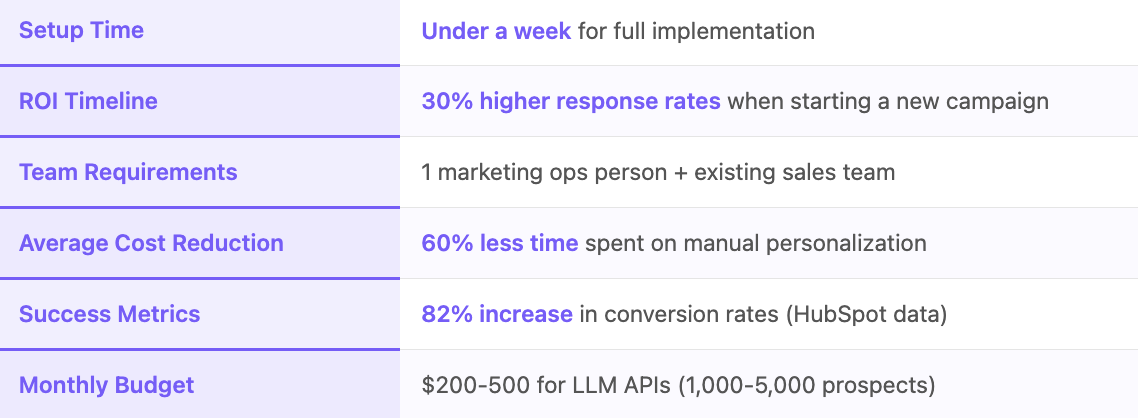
Consider this data point: personalized emails have 26% higher open rates and response rates that are 29% higher than generic bulk emails. But when you add AI-powered contextual personalization that references recent LinkedIn posts, company news, or specific pain points, those numbers jump even higher.
The challenge isn't whether to use AI - it's implementing it correctly. Most teams fall into common traps: over-relying on templates, ignoring context, or creating personalization that feels obviously automated. The solutions in this guide help you avoid these pitfalls.
Understanding LLM Capabilities for Email Personalization
Large Language Models have changed email personalization, but not all LLMs perform equally for this specific use case. Based on industry analysis and testing results, here's what each major LLM brings to email personalization.
GPT-4 and GPT-4o: The Gold Standard
GPT-4 remains the gold standard for email personalization because of its contextual understanding and ability to maintain consistent tone. Testing consistently shows GPT-4 produces more natural-sounding personalization than other models. It excels at understanding context from prospect data, maintains consistent brand voice across campaigns, and handles complex personalization scenarios effectively.
This makes it ideal for:
- Initial email drafts
- Complex prospect research synthesis
- Multi-touch campaign personalization
Claude 3.5 Sonnet: Excellent for Sequences
Claude 3.5 Sonnet excels at maintaining coherence across longer email sequences and understanding nuanced context. For teams running complex nurture campaigns, Claude often produces more contextually appropriate follow-ups. It performs exceptionally well on longer context windows, maintains conversation flow across email sequences, and shows strong understanding of professional communication norms.
Claude is also less prone to hallucination with prospect data, making it perfect for:
- Multi-email sequences
- Complex B2B sales cycles
- Technical product explanations
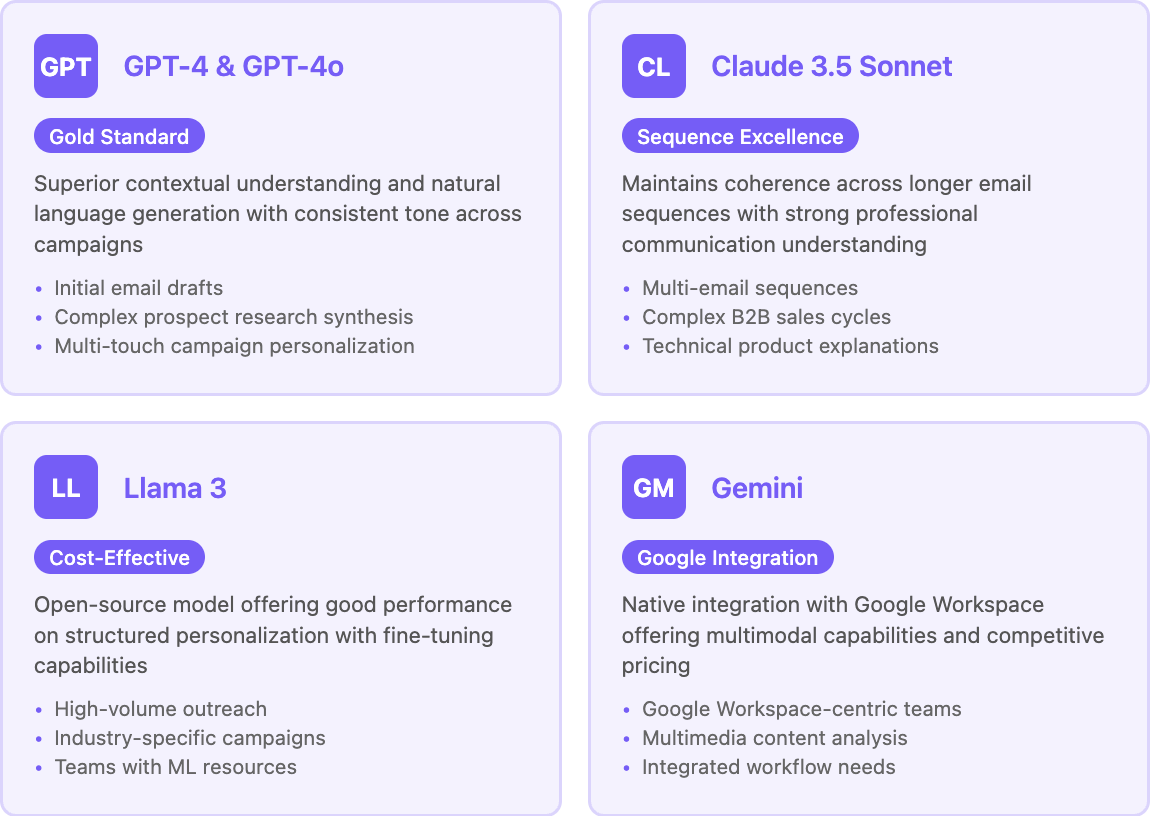
Llama 3: Cost-Effective Open Source
Llama 3's open-source nature makes it attractive for teams with technical resources who want to fine-tune models for specific use cases. Recent testing shows it performs surprisingly well for email content generation. Its cost-effective structure works well for high-volume campaigns, can be fine-tuned for industry-specific language, and offers good performance on structured personalization tasks without vendor lock-in concerns.
This makes it ideal for:
- High-volume outreach
- Industry-specific campaigns
- Teams with ML resources
Gemini: Google Workspace Integration
Gemini's integration with Google Workspace makes it compelling for teams already using Gmail, Google Docs, and related tools. The seamless workflow integration can significantly reduce implementation friction. It offers native integration with Gmail and Google Workspace, strong performance on research and data synthesis, multimodal capabilities for processing various content types, and competitive pricing structure.
This makes it perfect for:
- Google Workspace-centric teams
- Campaigns requiring multimedia content analysis
Practical Implementation Framework: From Setup to Scale
Phase 1: Foundation Building
Start with data infrastructure. The quality of your AI personalization depends entirely on the data you feed it. Here's what successful teams prioritize first.
Essential data sources:
- CRM prospect information (job title, company, industry)
- Company firmographic data (size, revenue, recent funding)
- Social media activity (LinkedIn posts, company news)
- Website behavior and engagement history
- Previous email interaction data
Technical setup requirements:
- API access to your chosen LLM provider
- Integration with your email sending platform
- Data enrichment tools for prospect research
- Testing environment for prompt optimization
Budget considerations typically involve teams spending $200-500 monthly on LLM APIs for campaigns reaching 1,000-5,000 prospects. The ROI typically covers costs within the first month through improved response rates.
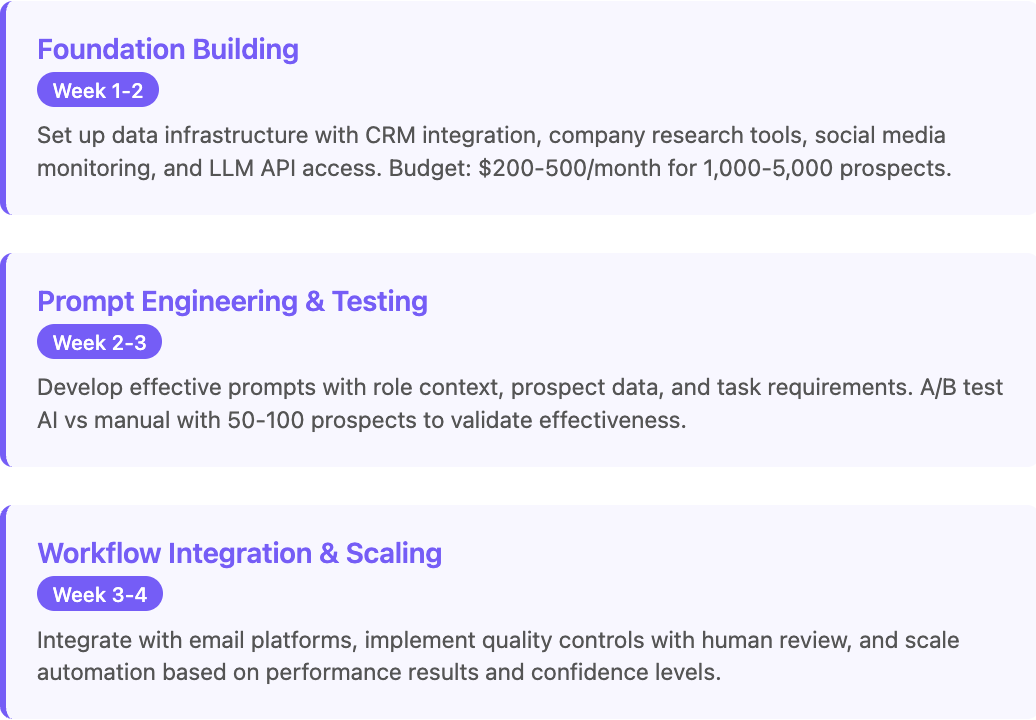
Phase 2: Prompt Engineering and Testing
Prompt engineering makes the difference between generic AI output and genuinely personalized emails. Based on analysis of successful implementations, here are proven prompt structures that actually work.
An effective personalization prompt should establish clear role context, provide comprehensive prospect data including name, company, role, and recent activity, then specify the exact task requirements. The task should focus on writing personalized email openers that reference specific, recent information about the prospect or company while connecting their situation to how your solution helps. The tone should remain conversational and professional, with openers limited to 2-3 sentences maximum.
Constraints become crucial here. You want to:
- Avoid obvious template language
- Prevent assumptions about specific challenges
- Include one specific, verifiable detail about their company
- Ensure the output sounds human-written rather than AI-generated
Testing approach should start with a small sample of 50-100 prospects and A/B test AI-generated personalization against your current manual approach. Track open rates, response rates, and reply sentiment to validate effectiveness before scaling.
Phase 3: Workflow Integration and Scaling
Seamless integration with existing tools ensures adoption and scalability. The most successful implementations follow a clear workflow progression.
The process starts with prospect identification and lead scoring, moves through data enrichment and company research automation, then applies AI personalization for LLM-generated custom messaging. Human review provides quality checks and brand voice alignment, followed by campaign execution with automated sending and tracking. Response handling uses AI-assisted reply categorization and routing to complete the cycle.
Quality control measures:
- Human review for all AI-generated content initially
- Gradual automation as confidence builds
- Regular audits of personalization quality
- A/B testing against control groups
Tools and Platform - Databar's Approach
Most AI personalization tools operate in isolation, requiring manual data transfer and disconnected workflows. This creates bottlenecks that limit scaling and introduce errors.
Databar solves this by integrating AI personalization directly into comprehensive data enrichment workflows. Instead of juggling multiple tools, our platform combines:
- Prospect research automation with access to 90+ data providers for comprehensive prospect intelligence
- AI-powered personalization offering multiple LLM options for generating custom messaging
- Campaign automation providing direct integration with email sending platforms
- Real-time data sync ensuring automatic updates to prospect information
Example workflow with Databar:
- Upload prospect list or use our lead generation tools
- Automatically enrich with firmographic, technographic, and intent data
- Generate AI-personalized email content using the enriched data
- Push complete campaigns directly to your email platform
- Track results and optimize based on performance data
This integrated approach eliminates the 60-80% of time most teams spend on data preparation and tool switching, letting you focus on refining messaging and closing deals.
Advanced Personalization Techniques That Actually Work
Beyond basic personalization, the highest-performing teams use sophisticated techniques that create genuine connections with prospects.
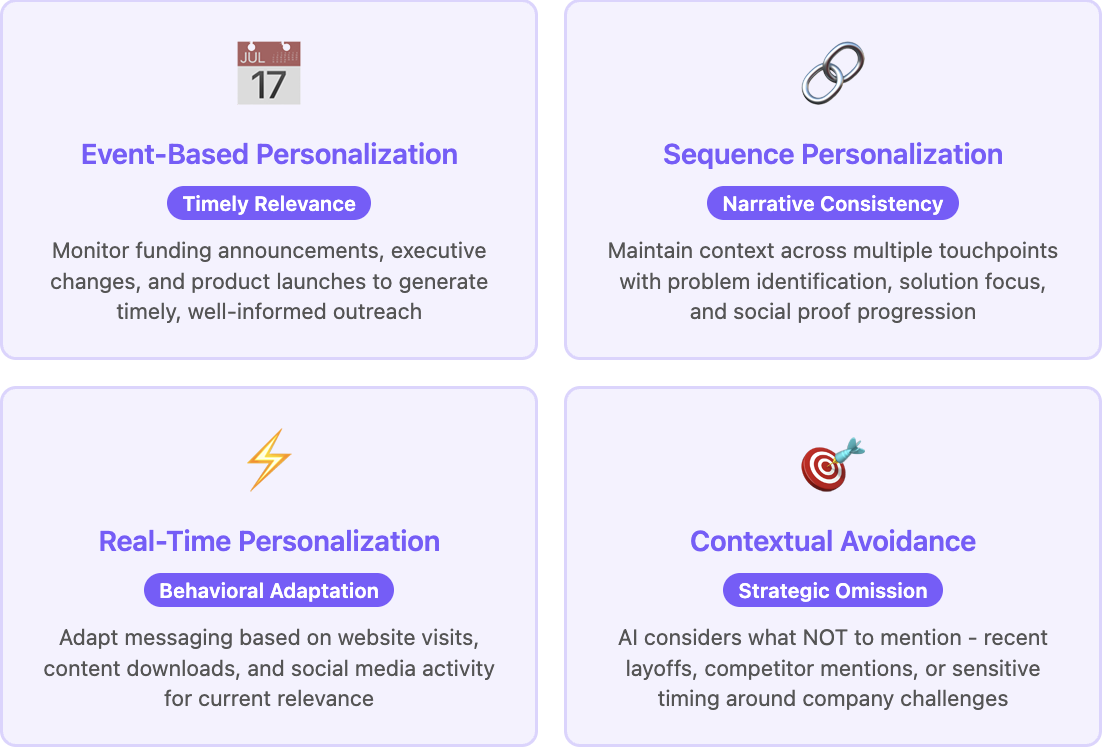
Event-Based Personalization
Event-based personalization performs significantly better than static approaches. Monitor for:
- Funding announcements and use AI to craft congratulatory messages tied to growth opportunities
- Executive changes and reach out to new decision-makers with relevant introductions
- Product launches and connect your solution to their go-to-market needs
- Industry news and position your expertise as relevant to current challenges
Implementation involves using news monitoring APIs combined with AI to automatically generate timely, relevant outreach that feels natural and well-informed.
Sequence Personalization
Sequence personalization requires maintaining context across multiple touchpoints while varying the messaging approach:
- First touch: Problem identification based on company research
- Second touch: Solution-focused messaging using their technology stack data
- Third touch: Social proof from similar companies in their industry
- Fourth touch: Direct value proposition with specific ROI calculations
- Fifth touch: Breakup email with additional resources
AI's role here involves generating variations for each touchpoint while maintaining narrative consistency and avoiding repetitive language that prospects notice immediately.
What Not to Mention
What you don't mention can be as important as what you do. Advanced AI personalization considers:
- Avoiding recently covered topics in their industry news
- Steering clear of competitors mentioned in their recent content
- Respecting sensitive timing around layoffs or company challenges
- Matching communication style to their recent content tone
Real-Time Personalization
Real-time personalization adapts messaging based on current prospect behavior:
- Website pages visited help tailor product focus
- Content downloaded reveals specific interests
- Email engagement patterns guide sending frequency and style adjustments
- Social media activity incorporates recent posts or achievements into messaging
This approach aligns with how the most effective waterfall enrichment tools for B2B sales teams combine multiple real-time data sources for comprehensive personalization.
Ready to Scale Your AI Email Personalization?
AI email personalization isn't just about better response rates—it's about creating genuine connections at scale while freeing your team to focus on high-value activities like closing deals and building relationships.
The teams that implement AI personalization correctly see immediate results: 29% higher response rates, 60% time savings on manual personalization, and 82% increase in conversion rates. But success requires the right approach, quality data, and integrated workflows that eliminate friction.
Start with one high-impact campaign, prove the ROI, and scale from there. The competitive advantage goes to teams that master AI personalization first, while others struggle with manual processes that can't keep pace with market demands.
Your prospects expect personalized, relevant outreach. AI gives you the tools to deliver that at scale while maintaining the human touch that drives real connections and business results.
Frequently Asked Questions
How much does AI email personalization typically cost? Most teams spend $200-500 monthly on LLM APIs for campaigns reaching 1,000-5,000 prospects. Platform costs vary widely: tools like Lyne.ai start around $40/month, while comprehensive solutions like Instantly.ai cost $100+ monthly. The ROI typically covers costs within 30 days through improved response rates.
Which LLM performs best for B2B email personalization? GPT-4 consistently delivers the highest quality personalization in testing, with superior contextual understanding and natural language generation. Claude 3.5 Sonnet excels for longer email sequences, while Llama 3 offers cost-effective performance for high-volume campaigns. Choose based on your specific needs and budget constraints.
How do you maintain brand voice with AI-generated emails? Successful teams develop detailed brand voice guidelines and include specific examples in their AI prompts. Start with AI-generated drafts that humans review and edit, gradually increasing automation as the AI learns your style. Regular quality audits and A/B testing help maintain consistency while scaling.
What's the minimum team size needed to implement AI email personalization? One marketing operations person plus existing sales team is sufficient for most implementations. The marketing ops person handles tool setup, prompt engineering, and quality control, while sales team members provide feedback on messaging quality and prospect insights.
Can AI personalization work for all industries and company sizes? AI personalization is effective across industries, but implementation approaches vary. Technical B2B companies benefit from product-focused personalization, while service companies focus on pain point identification. Company size affects volume and complexity but not fundamental effectiveness.
How do you ensure AI-generated personalization doesn't sound robotic? Combine AI research with human editing for best results. Use conversational prompts that emphasize natural language, include specific examples of your preferred style, and always review AI output before sending. Focus on contextual insights rather than template-filling approaches.
What data sources work best for AI email personalization? LinkedIn profiles, company news, and recent funding information provide the highest-quality personalization opportunities. Website content, job postings, and social media activity also work well. The key is using current, relevant information that demonstrates genuine research about the prospect.
How do you scale AI personalization without losing quality? Implement gradual automation with ongoing quality controls. Start with human review of all AI content, then automate high-confidence scenarios while maintaining spot checks. Use A/B testing to validate performance and adjust automation levels based on results rather than arbitrary timelines.
Related articles
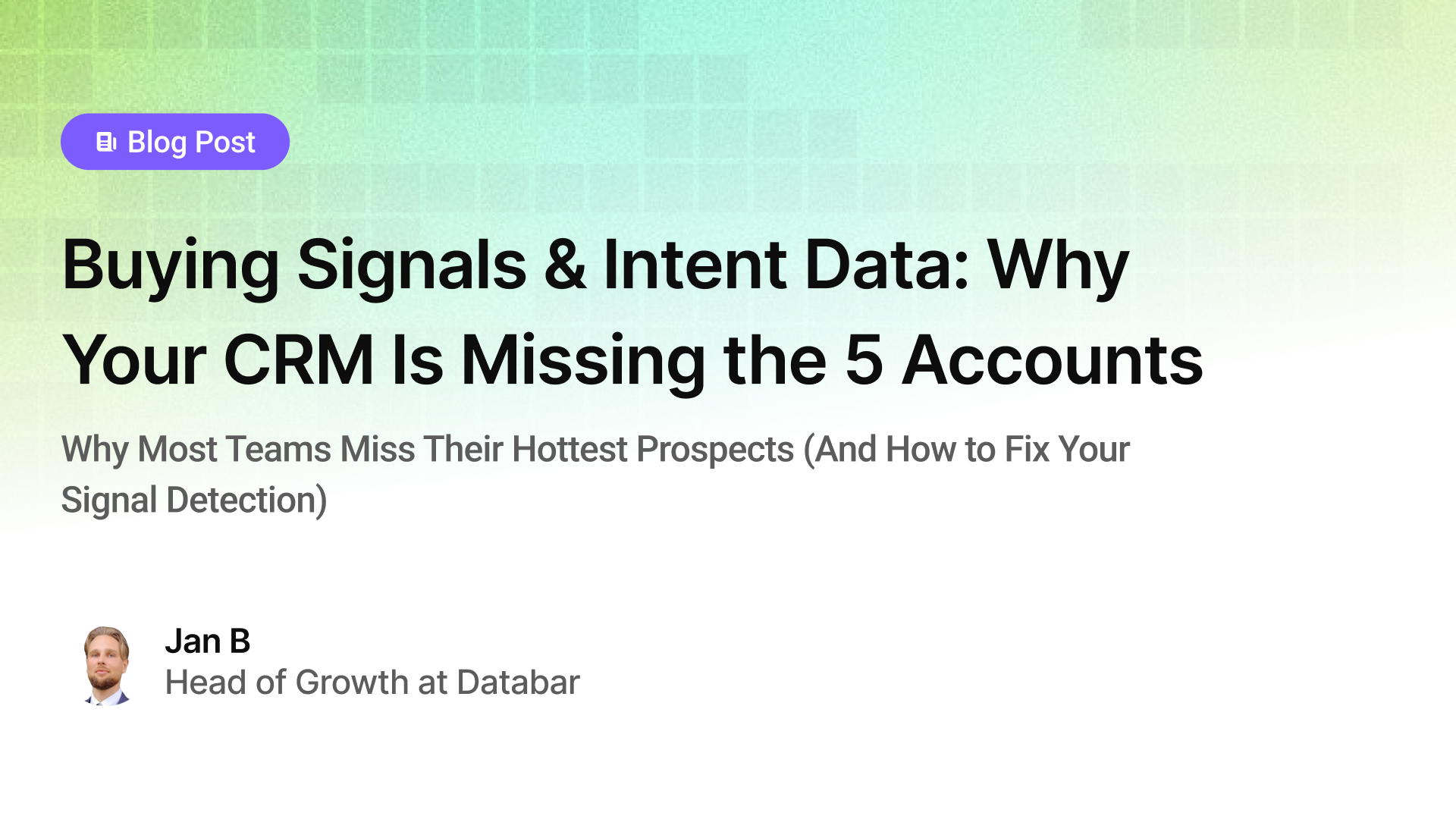
Buying Signals & Intent Data: Why Your CRM Is Missing the 5 Accounts
Why Most Teams Miss Their Hottest Prospects (And How to Fix Your Signal Detection)
by Jan, October 06, 2025

Lead Scoring & Account Segmentation: Why Most CRMs Get This Backward (And How to Fix It)
How to build a system that tells your team who to call, when, and why
by Jan, October 06, 2025
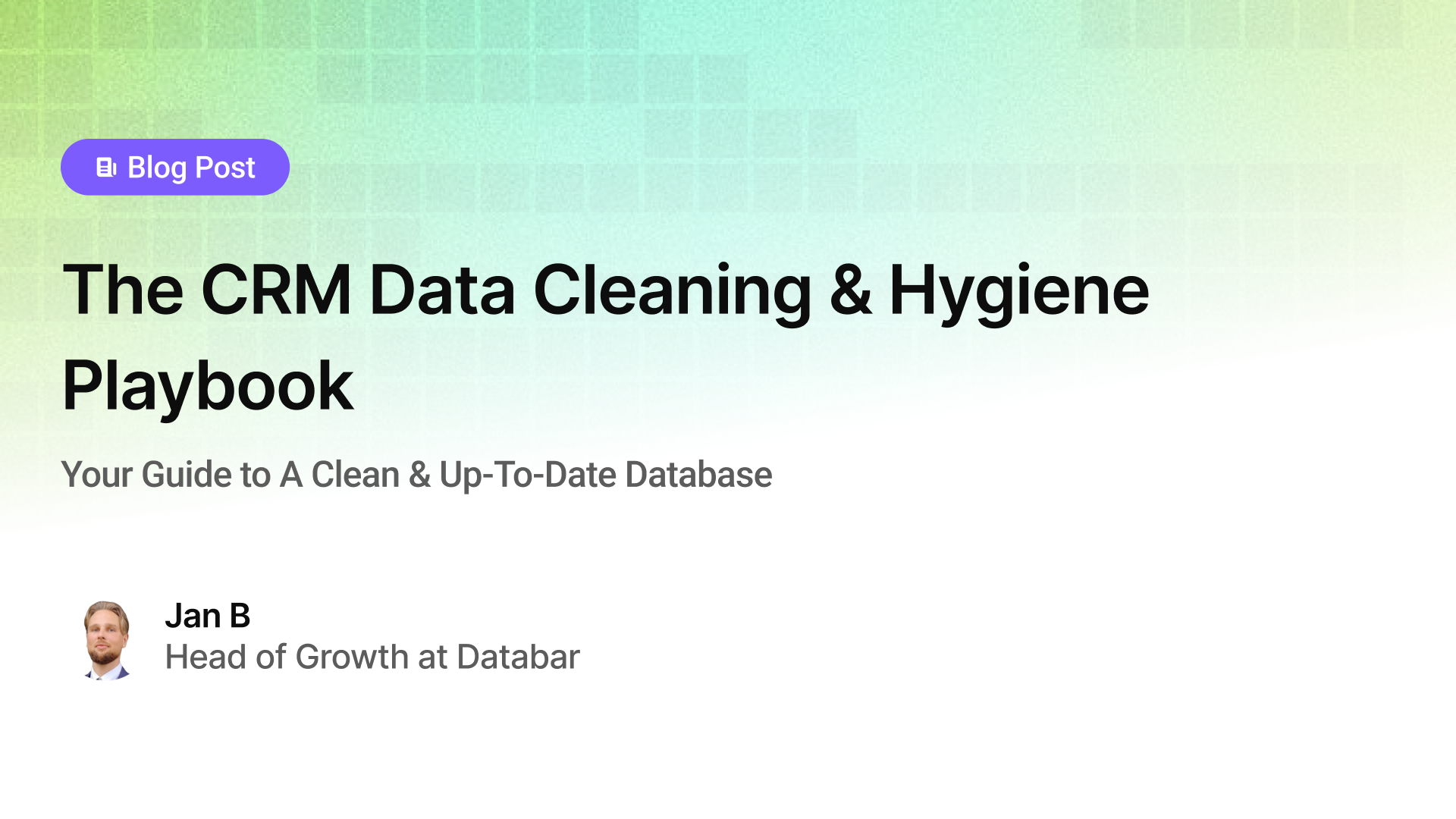
The CRM Data Cleaning & Hygiene Playbook
Your Guide to A Clean & Up-To-Date Database
by Jan, October 04, 2025
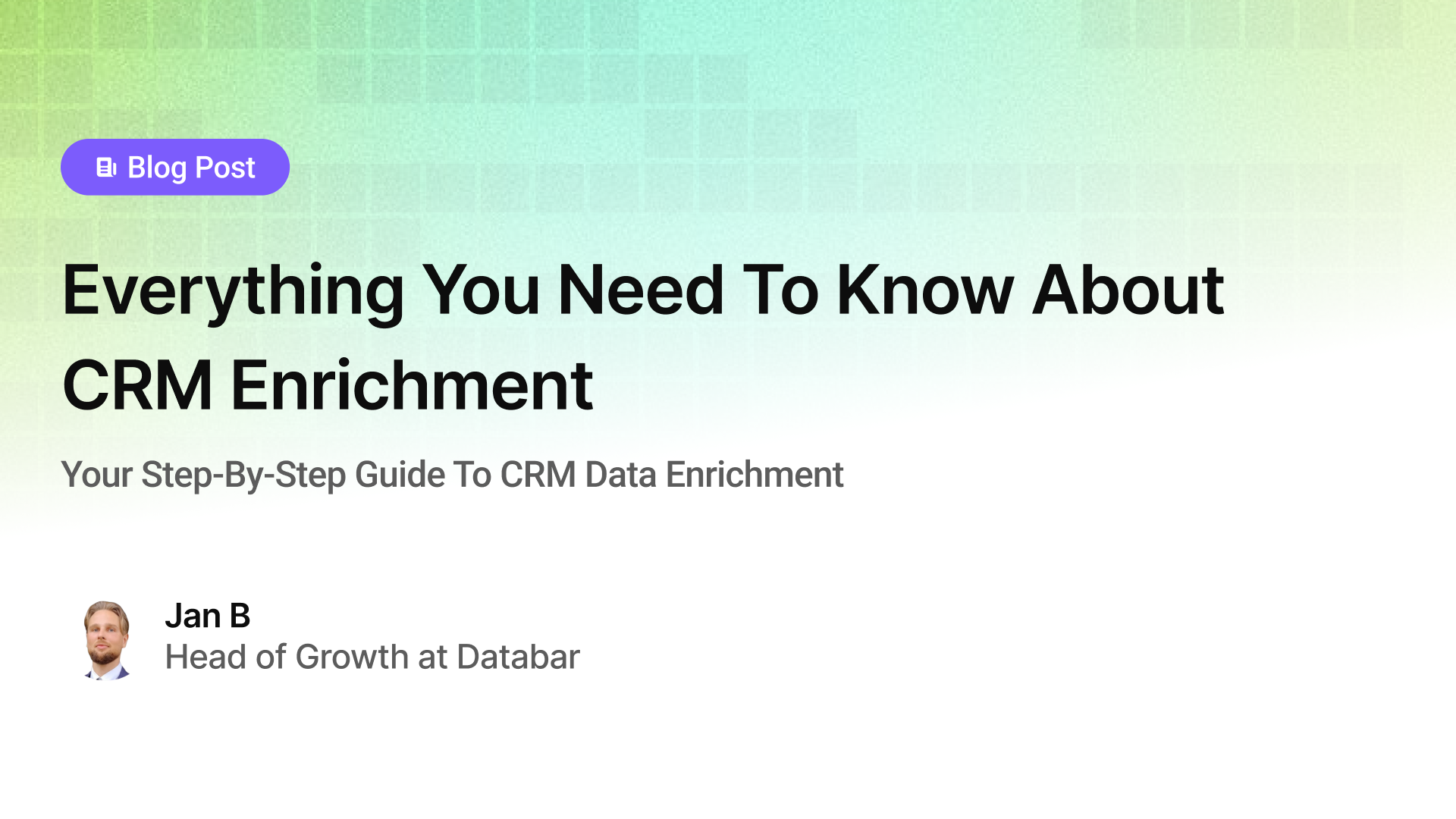
Everything You Need To Know About CRM Enrichment
Your Step-By-Step Guide To CRM Data Enrichment
by Jan, October 03, 2025

